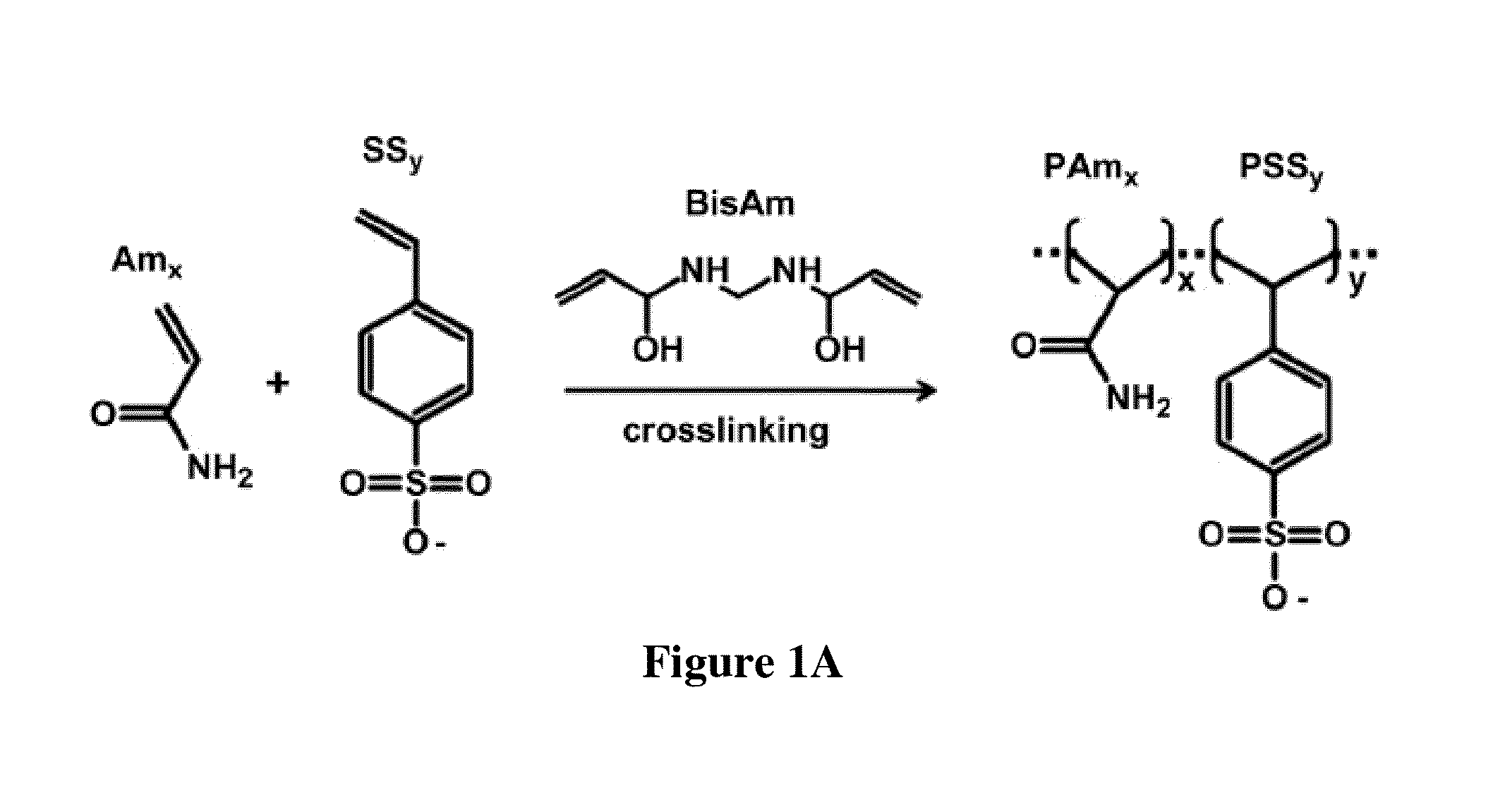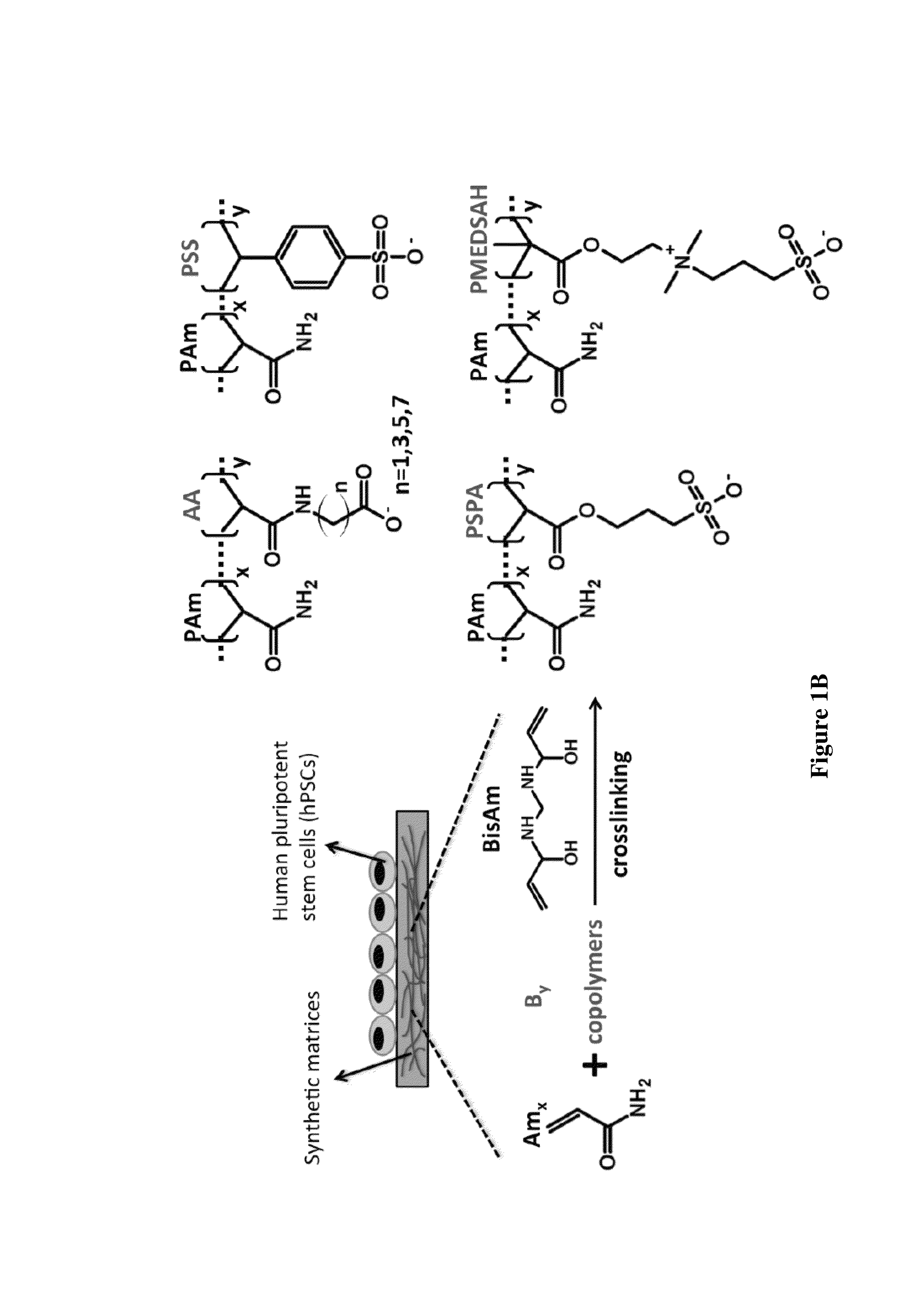Synthetic matrices for self-renewal and expansion of stem cells
a technology of stem cells and synthetic hydrogels, applied in the field of hydrogels, can solve the problem of difficult task of chemically defined matrices and the development of them
- Summary
- Abstract
- Description
- Claims
- Application Information
AI Technical Summary
Benefits of technology
Problems solved by technology
Method used
Image
Examples
example 1
Materials and Methods
[0062]Materials: The following monomers were used. N-acryloyl amino acid (AA) monomers, such as N-acryloyl 2-glycine (A2AGA), N-acryloyl 4-aminobutyeric acid (A4ABA), N-acryloyl 6-aminocaproic acid (A6ACA), and N-acryloyl 8-aminocaprylic acid (A8ACA), were synthesized from glycine (Fisher Scientific, Inc.), 4-aminobutyeric acid, 6-aminocaproic acid, and 8-aminocaprylic acid (Acros Organics Inc.). Sodium 4-vinylbenzenesulfonate (SS), 3-sulfopropyl acrylate potassium salt (SPA), and [2-(methacryloyloxy)ethyl]dimethyl-(3-sulfopropyl)ammonium hydroxide (MEDSAH) were purchased from Aldrich. Acrylamide (Am) was purchased from Invitrogen and N,N′-methylenebisacrylamide (BisAm), ammonium persulfate (APS) and N,N,N′,N′-tetramethylethylenediamine (TEMED) were obtained from Sigma.
[0063]Hydrogel preparation: The hydrogels containing varying functional groups and hydrophilicity were synthesized through copolymerization of acrylamide with monomers containing either carboxylat...
example 2
PCR Array Analysis for Various Extracellular Matrix Proteins
[0078]Briefly, RNA was isolated from cells using TRIzol (Invitrogen), and treated with DNase I (Invitrogen) to remove traces of DNA. Reverse transcription was performed by using RT2 First Strand Kit (SABioscience, Cat #330401) and 200 ng of cDNA was processed for quantitative real-time RT-PCR of 84 genes involved in extracellular matrix and adhesion molecules by using PCR array kit (RT2 Profiler™ PCR Arrays Extracellular matrix and adhesion molecules, PAHS-013A-2, SABioscience) an ABI Prism 7700 Sequence Detection System (Applied Biosystems). PCR products were quantified by measuring SYBR Green fluorescent dye incorporation with ROX dye reference.
[0079]Protein adsorption: The amount of various protein adsorptions to PAm6-co-A2AGA2 and PAm6-co-PSS2 hydrogels was quantified by a modified Bradford protein assay using Bio-Rad Protein Assay kit (Cat #500-0006). Briefly, the dye agent was prepared according to the manufacturer's ...
PUM
| Property | Measurement | Unit |
|---|---|---|
| Pressure | aaaaa | aaaaa |
| Pressure | aaaaa | aaaaa |
| Pressure | aaaaa | aaaaa |
Abstract
Description
Claims
Application Information
 Login to View More
Login to View More - R&D
- Intellectual Property
- Life Sciences
- Materials
- Tech Scout
- Unparalleled Data Quality
- Higher Quality Content
- 60% Fewer Hallucinations
Browse by: Latest US Patents, China's latest patents, Technical Efficacy Thesaurus, Application Domain, Technology Topic, Popular Technical Reports.
© 2025 PatSnap. All rights reserved.Legal|Privacy policy|Modern Slavery Act Transparency Statement|Sitemap|About US| Contact US: help@patsnap.com



